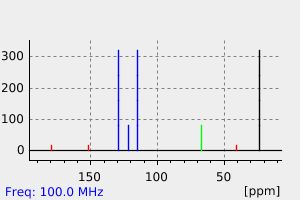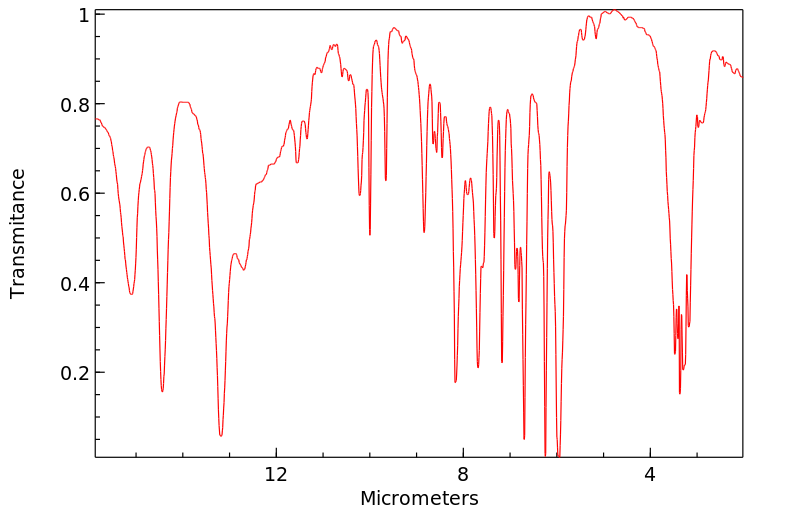4,4-二甲基菲尼酮 | 2654-58-2
中文名称
4,4-二甲基菲尼酮
中文别名
4,4-二甲基-1-苯基-3-吡唑酮;菲尼酮D;4,4-二甲基-1-苯基-3-吡唑烷酮
英文名称
4,4-dimethyl-1-phenylpyrazolidin-3-one
英文别名
Dimezone
CAS
2654-58-2
化学式
C11H14N2O
mdl
MFCD00044325
分子量
190.245
InChiKey
SJSJAWHHGDPBOC-UHFFFAOYSA-N
BEILSTEIN
——
EINECS
——
-
物化性质
-
计算性质
-
ADMET
-
安全信息
-
SDS
-
制备方法与用途
-
上下游信息
-
文献信息
-
表征谱图
-
同类化合物
-
相关功能分类
-
相关结构分类
物化性质
-
熔点:167-172 °C(lit.)
-
沸点:325.75°C (rough estimate)
-
密度:1.0815 (rough estimate)
-
闪点:195 °C
-
稳定性/保质期:
遵循规定使用和储存,则不会发生分解。
计算性质
-
辛醇/水分配系数(LogP):2.2
-
重原子数:14
-
可旋转键数:1
-
环数:2.0
-
sp3杂化的碳原子比例:0.363
-
拓扑面积:32.3
-
氢给体数:1
-
氢受体数:2
安全信息
-
危险等级:6.1
-
危险品标志:T
-
安全说明:S24,S26,S28A,S36/37,S37/39,S45
-
危险类别码:R36/37/38,R25,R43
-
WGK Germany:2
-
RTECS号:UQ8710000
-
海关编码:2933990090
-
包装等级:II
-
危险类别:6.1
-
危险品运输编号:UN 2811 6.1/PG 2
-
储存条件:存于阴凉干燥处。
SDS
| Name: | 4 4-Dimethyl-1-phenyl-3-pyrazolidone 99% Material Safety Data Sheet |
| Synonym: | 3-pyrazolidinone, 4,4-dimethyl-1-phenyl |
| CAS: | 2654-58-2 |
Synonym:3-pyrazolidinone, 4,4-dimethyl-1-phenyl
Section 2 - COMPOSITION, INFORMATION ON INGREDIENTS
| CAS# | Chemical Name | content | EINECS# |
| 2654-58-2 | 3-pyrazolidinone, 4,4-dimethyl-1-pheny | 99 | 220-181-1 |
Risk Phrases: 20/21/22 36/37/38
Section 3 - HAZARDS IDENTIFICATION
EMERGENCY OVERVIEW
Harmful by inhalation, in contact with skin and if swallowed.
Irritating to eyes, respiratory system and skin.The toxicological properties of this material have not been fully investigated.
Potential Health Effects
Eye:
Dust may cause mechanical irritation. No information reported.
Skin:
May cause skin irritation. No information reported.
Ingestion:
May cause irritation of the digestive tract. The toxicological properties of this substance have not been fully investigated.
Inhalation:
May cause respiratory tract irritation. The toxicological properties of this substance have not been fully investigated.
Chronic:
No information found.
Section 4 - FIRST AID MEASURES
Eyes: Flush eyes with plenty of water for at least 15 minutes, occasionally lifting the upper and lower eyelids. Get medical aid.
Skin:
Flush skin with plenty of water for at least 15 minutes while removing contaminated clothing and shoes. Get medical aid if irritation develops or persists.
Ingestion:
If victim is conscious and alert, give 2-4 cupfuls of milk or water.
Never give anything by mouth to an unconscious person. Get medical aid.
Inhalation:
Remove from exposure and move to fresh air immediately. If not breathing, give artificial respiration. If breathing is difficult, give oxygen. Get medical aid if cough or other symptoms appear.
Notes to Physician:
Section 5 - FIRE FIGHTING MEASURES
General Information:
As in any fire, wear a self-contained breathing apparatus in pressure-demand, MSHA/NIOSH (approved or equivalent), and full protective gear.
Extinguishing Media:
For small fires, use water spray, dry chemical, carbon dioxide or chemical foam.
Section 6 - ACCIDENTAL RELEASE MEASURES
General Information: Use proper personal protective equipment as indicated in Section 8.
Spills/Leaks:
Vacuum or sweep up material and place into a suitable disposal container. Avoid generating dusty conditions.
Section 7 - HANDLING and STORAGE
Handling:
Wash hands before eating. Use with adequate ventilation. Avoid contact with skin and eyes. Avoid ingestion and inhalation.
Storage:
Store in a cool, dry, well-ventilated area away from incompatible substances.
Section 8 - EXPOSURE CONTROLS, PERSONAL PROTECTION
Engineering Controls:
Use process enclosure, local exhaust ventilation, or other engineering controls to control airborne levels.
Exposure Limits CAS# 2654-58-2: Personal Protective Equipment Eyes: Wear appropriate protective eyeglasses or chemical safety goggles as described by OSHA's eye and face protection regulations in 29 CFR 1910.133 or European Standard EN166.
Skin:
Wear appropriate protective gloves to prevent skin exposure.
Clothing:
Wear appropriate protective clothing to prevent skin exposure.
Respirators:
Follow the OSHA respirator regulations found in 29 CFR 1910.134 or European Standard EN 149. Use a NIOSH/MSHA or European Standard EN 149 approved respirator if exposure limits are exceeded or if irritation or other symptoms are experienced.
Section 9 - PHYSICAL AND CHEMICAL PROPERTIES
Physical State: Solid
Color: white to off-white to pink
Odor: Not available.
pH: Not available.
Vapor Pressure: Not available.
Viscosity: Not available.
Boiling Point: Not available.
Freezing/Melting Point: 167.00 - 169.00 deg C
Autoignition Temperature: Not available.
Flash Point: Not available.
Explosion Limits, lower: Not available.
Explosion Limits, upper: Not available.
Decomposition Temperature:
Solubility in water: soluble
Specific Gravity/Density:
Molecular Formula: C11H14N2O
Molecular Weight: 190.24
Section 10 - STABILITY AND REACTIVITY
Chemical Stability:
Stable under normal temperatures and pressures.
Conditions to Avoid:
Strong oxidants.
Incompatibilities with Other Materials:
None reported.
Hazardous Decomposition Products:
No data available.
Hazardous Polymerization: Has not been reported.
Section 11 - TOXICOLOGICAL INFORMATION
RTECS#:
CAS# 2654-58-2: UQ8710000 LD50/LC50:
CAS# 2654-58-2: Oral, rat: LD50 = 30 mg/kg.
Carcinogenicity:
3-pyrazolidinone, 4,4-dimethyl-1-phenyl- - Not listed by ACGIH, IARC, or NTP.
Other:
See actual entry in RTECS for complete information.
Section 12 - ECOLOGICAL INFORMATION
Section 13 - DISPOSAL CONSIDERATIONS
Dispose of in a manner consistent with federal, state, and local regulations.
Section 14 - TRANSPORT INFORMATION
IATA
Not regulated as a hazardous material.
IMO
Not regulated as a hazardous material.
RID/ADR
Not regulated as a hazardous material.
Section 15 - REGULATORY INFORMATION
European/International Regulations
European Labeling in Accordance with EC Directives
Hazard Symbols: XN
Risk Phrases:
R 20/21/22 Harmful by inhalation, in contact with
skin and if swallowed.
R 36/37/38 Irritating to eyes, respiratory system
and skin.
Safety Phrases:
S 26 In case of contact with eyes, rinse immediately
with plenty of water and seek medical advice.
S 36/37/39 Wear suitable protective clothing, gloves
and eye/face protection.
WGK (Water Danger/Protection)
CAS# 2654-58-2: No information available.
Canada
CAS# 2654-58-2 is listed on Canada's DSL List.
CAS# 2654-58-2 is not listed on Canada's Ingredient Disclosure List.
US FEDERAL
TSCA
CAS# 2654-58-2 is listed on the TSCA inventory.
SECTION 16 - ADDITIONAL INFORMATION
N/A
上下游信息
反应信息
-
作为反应物:描述:4,4-二甲基菲尼酮 在 dichloro(pentamethylcyclopentadienyl)rhodium (III) dimer 、 氘代甲醇 、 二环己胺 作用下, 反应 0.5h, 生成 4,4-dimethyl-1-phenylpyrazolidin-3-one参考文献:名称:通过 1-苯基吡唑烷酮与 α,α-二氟亚甲基炔烃的级联反应选择性合成 3-(α-氟乙烯基) 吲哚和 3-酰基吲哚摘要:本文介绍了通过1-苯基吡唑烷酮与 α,α-二氟亚甲基炔烃的偶联选择性合成 3-(α-氟乙烯基) 吲哚和 3-酰基吲哚。从机制上讲,3-(α-氟乙烯基)吲哚的形成是由一个级联过程引起的,包括Rh(III)催化的邻-C-H键断裂、区域选择性三键插入、吡唑烷酮开环、吲哚成环和HF消除。有趣的是,当该反应在 CH 3 OH/H 2 O 中而不是 CH 3 中进行时CN,原位形成的 3-(α-氟乙烯基)吲哚很容易经过水合过程得到 3-酰基吲哚衍生物。该协议具有选择性可控、同时形成杂环支架和单氟烯基部分、原子经济性、底物多样性、良好的官能团耐受性和氧化还原中性反应条件等特点。针对两种人类癌细胞系的选定产品的抗癌筛选证明了它们作为药物开发先导化合物的潜力。DOI:10.1002/adsc.202100441
-
作为产物:描述:3-羟基-2,2-二甲基-2'-苯基丙酰肼 在 PPA 作用下, 生成 4,4-二甲基菲尼酮参考文献:名称:Process for preparing 3-pyrazolidones摘要:公开号:US02843598A1
-
作为试剂:描述:甲醇 、 2-methyl-2-(3-phenylprop-2-yn-1-yl)cyclopentane-1,3-dione 、 在 4,4-二甲基菲尼酮 、 [ruthenium(II)(η6-1-methyl-4-isopropyl-benzene)(chloride)(μ-chloride)]2 、 sodium acetate 作用下, 反应 0.5h, 生成参考文献:名称:Ru(II)通过CH / CC键裂解催化可调级联反应。摘要:已经开发了通过C–H / C–C键活化从吡唑烷酮,2-炔酮和烷基醇轻松合成各种3-(烷氧基烷基)-1 H-吲哚的方法。在适当的反应条件下,反应可以顺利进行,初步的机理研究表明,NaOAc对于C–C键的活化至关重要。本方法的优点代表氧化还原中性过程,并表现出优异的化学和区域选择性。DOI:10.1021/acs.joc.0c01614
文献信息
-
Enantioselective Enolate Protonation in Sulfa–Michael Addition to α-Substituted <i>N</i>-Acryloyloxazolidin-2-ones with Bifunctional Organocatalyst作者:Nirmal K. Rana、Vinod K. SinghDOI:10.1021/ol202808n日期:2011.12.16Organocatalytic conjugate addition of thiols to α-substituted N-acryloyloxazolidin-2-ones followed by asymmetric protonation has been studied in the presence of cinchona alkaloid derived thioureas. Both of the enantiomers are accessible with the same level of enantioselectivity using pseudoenantiomeric quinine/quinidine derived catalysts. The addition/protonation products have been converted to useful biologically
-
Ruthenium-Catalyzed Redox-Neutral C–H Activation via N–N Cleavage: Synthesis of N-Substituted Indoles作者:Zhenxing Zhang、Hao Jiang、Yong HuangDOI:10.1021/ol502998n日期:2014.11.21The first Ru-catalyzed redox-neutral C–H activation reaction via N–N bond cleavage is reported. Pyrazolidin-3-one is demonstrated as an internally oxidative directing group that enables C–H annulation reactions with a broad scope of alkynes, including previously incompetent terminal alkynes. Pharmacologically privileged 3-(1H-indol-1-yl)propanamides were synthesized in high yields.
-
一种吡唑烷酮并苯并1,3-氧氮杂卓类化合物的合成方法
-
Rhodium-catalyzed redox-neutral coupling of phenidones with alkynes作者:Zhoulong Fan、Heng Lu、Wei Li、Kaijun Geng、Ao ZhangDOI:10.1039/c7ob01271c日期:——A switchable synthesis of N-substituted indole derivatives from phenidones via rhodium-catalyzed redox-neutral C–H activation has been achieved. In this protocol, we firstly disclosed that the reactivity of Rh(III) catalysis could be enhanced through employing palladium acetate as an additive. Some representative features include external oxidant-free, applicable to terminal alkynes, short reaction
-
Construction of Pyridazine Analogues <i>via</i> Rhodium-mediated C-H Activation作者:Chao Yang、Feifei Song、Jiean Chen、Yong HuangDOI:10.1002/adsc.201700905日期:2017.10.25Herein a rhodium (III)‐mediated catalysis was demonstrated for approaching the structurally divergent N,N‐bicyclic pyridazine analogues. The pyrazolidinone moiety was used to direct the ortho C−H activation and this led to a general synthesis of benzopyridazine analogues with satisfactory yields. The crucial effect of the base was illustrated in the sequential dehydration process. For mechanistic insight
表征谱图
-
氢谱1HNMR
-
质谱MS
-
碳谱13CNMR
-
红外IR
-
拉曼Raman
-
峰位数据
-
峰位匹配
-
表征信息
同类化合物
(βS)-β-氨基-4-(4-羟基苯氧基)-3,5-二碘苯甲丙醇
(S,S)-邻甲苯基-DIPAMP
(S)-(-)-7'-〔4(S)-(苄基)恶唑-2-基]-7-二(3,5-二-叔丁基苯基)膦基-2,2',3,3'-四氢-1,1-螺二氢茚
(S)-盐酸沙丁胺醇
(S)-3-(叔丁基)-4-(2,6-二甲氧基苯基)-2,3-二氢苯并[d][1,3]氧磷杂环戊二烯
(S)-2,2'-双[双(3,5-三氟甲基苯基)膦基]-4,4',6,6'-四甲氧基联苯
(S)-1-[3,5-双(三氟甲基)苯基]-3-[1-(二甲基氨基)-3-甲基丁烷-2-基]硫脲
(R)富马酸托特罗定
(R)-(-)-盐酸尼古地平
(R)-(-)-4,12-双(二苯基膦基)[2.2]对环芳烷(1,5环辛二烯)铑(I)四氟硼酸盐
(R)-(+)-7-双(3,5-二叔丁基苯基)膦基7''-[((6-甲基吡啶-2-基甲基)氨基]-2,2'',3,3''-四氢-1,1''-螺双茚满
(R)-(+)-7-双(3,5-二叔丁基苯基)膦基7''-[(4-叔丁基吡啶-2-基甲基)氨基]-2,2'',3,3''-四氢-1,1''-螺双茚满
(R)-(+)-7-双(3,5-二叔丁基苯基)膦基7''-[(3-甲基吡啶-2-基甲基)氨基]-2,2'',3,3''-四氢-1,1''-螺双茚满
(R)-(+)-4,7-双(3,5-二-叔丁基苯基)膦基-7“-[(吡啶-2-基甲基)氨基]-2,2”,3,3'-四氢1,1'-螺二茚满
(R)-3-(叔丁基)-4-(2,6-二苯氧基苯基)-2,3-二氢苯并[d][1,3]氧杂磷杂环戊烯
(R)-2-[((二苯基膦基)甲基]吡咯烷
(R)-1-[3,5-双(三氟甲基)苯基]-3-[1-(二甲基氨基)-3-甲基丁烷-2-基]硫脲
(N-(4-甲氧基苯基)-N-甲基-3-(1-哌啶基)丙-2-烯酰胺)
(5-溴-2-羟基苯基)-4-氯苯甲酮
(5-溴-2-氯苯基)(4-羟基苯基)甲酮
(5-氧代-3-苯基-2,5-二氢-1,2,3,4-oxatriazol-3-鎓)
(4S,5R)-4-甲基-5-苯基-1,2,3-氧代噻唑烷-2,2-二氧化物-3-羧酸叔丁酯
(4S,4''S)-2,2''-亚环戊基双[4,5-二氢-4-(苯甲基)恶唑]
(4-溴苯基)-[2-氟-4-[6-[甲基(丙-2-烯基)氨基]己氧基]苯基]甲酮
(4-丁氧基苯甲基)三苯基溴化磷
(3aR,8aR)-(-)-4,4,8,8-四(3,5-二甲基苯基)四氢-2,2-二甲基-6-苯基-1,3-二氧戊环[4,5-e]二恶唑磷
(3aR,6aS)-5-氧代六氢环戊基[c]吡咯-2(1H)-羧酸酯
(2Z)-3-[[(4-氯苯基)氨基]-2-氰基丙烯酸乙酯
(2S,3S,5S)-5-(叔丁氧基甲酰氨基)-2-(N-5-噻唑基-甲氧羰基)氨基-1,6-二苯基-3-羟基己烷
(2S,2''S,3S,3''S)-3,3''-二叔丁基-4,4''-双(2,6-二甲氧基苯基)-2,2'',3,3''-四氢-2,2''-联苯并[d][1,3]氧杂磷杂戊环
(2S)-(-)-2-{[[[[3,5-双(氟代甲基)苯基]氨基]硫代甲基]氨基}-N-(二苯基甲基)-N,3,3-三甲基丁酰胺
(2S)-2-[[[[[((1S,2S)-2-氨基环己基]氨基]硫代甲基]氨基]-N-(二苯甲基)-N,3,3-三甲基丁酰胺
(2S)-2-[[[[[[((1R,2R)-2-氨基环己基]氨基]硫代甲基]氨基]-N-(二苯甲基)-N,3,3-三甲基丁酰胺
(2-硝基苯基)磷酸三酰胺
(2,6-二氯苯基)乙酰氯
(2,3-二甲氧基-5-甲基苯基)硼酸
(1S,2S,3S,5S)-5-叠氮基-3-(苯基甲氧基)-2-[(苯基甲氧基)甲基]环戊醇
(1S,2S,3R,5R)-2-(苄氧基)甲基-6-氧杂双环[3.1.0]己-3-醇
(1-(4-氟苯基)环丙基)甲胺盐酸盐
(1-(3-溴苯基)环丁基)甲胺盐酸盐
(1-(2-氯苯基)环丁基)甲胺盐酸盐
(1-(2-氟苯基)环丙基)甲胺盐酸盐
(1-(2,6-二氟苯基)环丙基)甲胺盐酸盐
(-)-去甲基西布曲明
龙蒿油
龙胆酸钠
龙胆酸叔丁酯
龙胆酸
龙胆紫-d6
龙胆紫








